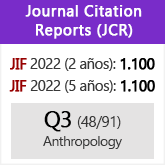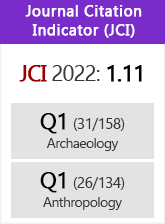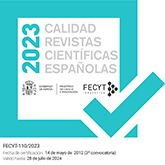La tumba hipogea de Bolores (Torres Vedras): una aproximación interdisciplinar a la comprensión del paisaje social del Neolítico Final/Edad del Cobre de la Península Ibérica
DOI:
https://doi.org/10.3989/tp.2014.12135Palabras clave:
Península Ibérica, Portugal, Arqueología de la Muerte, Demografía, Marcadores isotópicos de dieta y movilidad, Neolítico, Calcolítico, SIGResumen
Para comprender mejor el paisaje sociopolítico de la Extremadura portuguesa durante el Neolítico Final/Edad del Cobre se han llevado a cabo excavaciones interdisciplinares en Bolores (Torres Vedras), en el valle del río Sizandro. Tras una campaña de prueba en 1986, un equipo de la Universidad de Iowa realizó cuatro campañas entre 2007 y 2012. Bolores es una tumba hipogea que fue utilizada principalmente entre 2800 y 2600 cal BCE como enterramiento colectivo para adultos, adolescentes y niños (NMI=36). Los datos arquitectónicos, bioarqueológicos y de cultura material analizados hasta la fecha sugieren que Bolores albergó los restos de un grupo social distintivo compuesto de individuos locales que marcaban sus diferencias con otras poblaciones funerarias del Sizandro y Extremadura portuguesa mediante la cultura material y la arquitectura funeraria. Las diferencias sociales en la población de Bolores fueron señaladas espacialmente y marcadas mediante las ofrendas de bienes materiales. Sin embargo, no se aprecia una estratificación social significativa que sugiera una sociedad de nivel estatal: no hay enterramientos infantiles ricos, ni disparidades en la salud o dieta de esta población funeraria o entre esta población y otras en la región de Torres Vedras.
Descargas
Citas
Acsádi, G. W. and Nemeskéri, J. 1970: History of the Human Life Span and Mortality. Akadémiai Kiadó. Budapest.
AlQahtani, S. J.; Hector, M. P. and Liversidge, H. M. 2010: "Brief communication: the London atlas of human tooth development and eruption". American Journal of Physical Anthropology 142: 481-490. http://dx.doi.org/10.1002/ajpa.21258
Almagro Gorbea, M. J. 1973: Los ídolos del Bronce I Hispánico. Bibliotheca Praehistorica Hispana XII, CSIC. Madrid.
Ambrose, S. H., Butler, B. M., Hanson, D. B., Hunter-Anderson, R. L., and Krueger, H. W. 1997: "Stable isotopic analysis of human diet in the Marianas Archipelago, Western Pacific". American Journal of Physical Anthropology,104 (3): 343-361. http://dx.doi.org/10.1002/(SICI)1096-8644(199711)104:3<343::AID-AJPA5>3.0.CO;2-W
Anonymous 1991: "Serviços Geologicos de Portugal". Carta Geológica de Portugal 1:500,000. Lisbon, 5.ª edição.
Baker, B. J.; Dupras, T. K. and Tocheri, M. W. 2005: The Osteology of Infants and Children. Texas A & M University Press. College Station, Texas.
Belo, A. R.; Trindade, L. and Ferreira, O. da Veiga 1961: "A gruta da Cova da Moura (Torres Vedras)". Comunicações dos Serviços Geológicos de Portugal 45: 391-418.
Bronk Ramsey, C. 2013: OxCal 4.2.2. http://c14.arch.ox.ac.uk/oxcal
Brooks, S. T. and Suchey, J. M. 1990: "Skeletal age determination based on the os pubis: a comparison of the Acsádi-Nemeskéri and Suchey-Brooks methods". Journal of Human Evolution and Human Behavior 5: 227-238.
Brothwell, D. R. 1981: Digging up Bones. Cornell University Press. Ithaca.
Buikstra, J. and Ubelaker, D. (eds.) 1994: Standards for Data Collection from Human Skeletal Remains: Proceedings of a Seminar at the Field Museum of Natural History. Arkansas Archeological Survey. Fayetteville.
Dabrio, C. J.; Zazo, C.; Goy, J. L.; Sierro, F. J.; Borja, F.; Lario, J.; González, J. A. andFlores, J. A. 2000: "Depositional history of estuarine infill during the last postglacial transgression (Gulf of Cadiz, Southern Spain)". Marine Geology 162: 381-404. http://dx.doi.org/10.1016/S0025-3227(99)00069-9
Dabrio, C. J.; Zazo, C.; Lario, J.; Goy, J. L.; Sierro, F. J.; Borja, F.; Gonzalez, J. A., and Flores, J. A. 1999: "Sequence stratigraphy of Holocene incised-valley fills and coastal evolution in the Gulf of Cadiz (southern Spain)". Geologie en Mijnbouw 77 (3-4): 263-281.
Dambeck, R.; Thiemeyer, H.; Herrmann, N.; Joop Kalis, A.; Kunst, M.; Lord, A.; Rittweger, H.; Stika, H. P. and Stobbe, A. 2010: "Holozäne Talentwicklung und Landschaftswandel am Rio Sizandro. Geoarchäologische Beiträge zum 'Projekt Sizandro-Alcabrichel' (Portugal)". Madrider Mitteilungen 51: 9-46.
Dias, J. M. A.; Boski, T.; Rodrigues, A. and Magalhães, F. 2000: "Coast line evolution in Portugal since the Last Glacial Maximum until present –a synthesis". Marine Geology 170: 177-186. http://dx.doi.org/10.1016/S0025-3227(00)00073-6
Ferreira, O. da Veiga. 1970: "Grutas artificiais da Quinta das Lapas (Torres Vedras)". Junta Distrital de Lisboa, Boletim Cultural 73/74: 177-187.
Ferreira, O. da Veiga and Trindade, L. 1955: "A necrópole do Cabeço da Arruda (Torres Vedras)". Anais da Faculdade de Ciências do Porto 38 (3): 193-212.
Gallay, G.; Spindler, K.; Trindade, L. and Ferreira, O. da Veiga 1973: O monumento préhistórico de Pai Mogo (Lourinhã). Associação dos Arqueólogos Portugueses. Lisbon.
Gonçalves, V. dos S. 2008: As ocupações pré-históricas das furnas do Poço Velho, Cascais. Câmara Municipal de Cascais. Cascais.
Hillson, S. 1996: Dental Anthropology. Cambridge University Press. Cambridge. http://dx.doi.org/10.1017/CBO9781139170697
Hillson, S. 2005: Teeth. Cambridge University Press. Cambridge. http://dx.doi.org/10.1017/CBO9780511614477
Hoffman, G. 1990: "Zur holozänen Landschaftsentwicklung im Tal des Rio Sizandro (Portugal)". Madrider Mitteilungen 31: 21-33.
Hoffman, G. and Schulz, H. D. 1995: "Cambio de situación de la línea costera y estratigrafía del Holoceno en el Valle del Río Sizandro/Portugal". In M. Kunst (ed.): Origens, Estruturas e Relações das Culturas Calcolíticas da Península Ibérica. Actas das Ias Jornadas Arqueológicas de Torres Vedras (Torres Vedras 1987): 45-46. Lisboa.
Jordão, P. and Mendes, P. 2006/2007: "As grutas artificiais da Estremadura portuguesa: uma leitura crítica das arquitecturas". Arqueologia e História 58/59: 43-78.
Juárez Martín, J. M.; Moreno, E.; Cáceres, P.; Lacalle, R.; Guijo, J. M.; Nieto, J. M.; Aguilar, J. A. and Rico, E. 2010: El enterramiento en cueva artificial de La Molina (Lora de Estepa, Sevilla). Arqueología monografías, Consejería de Cultura, Junta de Andalucía. Sevilla.
King, J. B. 1939: "Calcification of the costal cartilages". British Journal of Radiology 12 (133): 2-12. http://dx.doi.org/10.1259/0007-1285-12-133-2
Kunst, M. 2007: "Zambujal (Torres Vedras, Lisboa): Relatório das escavações de 2001". Revista Portuguesa de Arqueologia 10 (1): 95-118.
Kunst, M. and Lutz, N. 2008: "Zambujal (Torres Vedras, Portugal). Zur Präzision der absoluten Chronologie durch die Untersuchungen an der vierten Befestigungslinie". Madrider Mitteilungen 49: 29-63.
Kunst, M. and Trindade, L. 1990: "Zur Besiedlungesgeschicte des Sizandrotals: Ergebnisse aus der Kustenforschung". Madrider Mitteilungen 31: 34-83.
Kunst, M. and Uerpmann, H. P. 1996: "Zambujal (Portugal). Vorbericht über die grabungen 1994". Madrider Mitteilungen 37: 10-36.
Kunst, M. and Uerpmann, H. P. 2002: "Zambujal (Torres Vedras, Lisboa). Relatório das escavações de 1994 e 1995". Revista Portuguesa de Arqueologia 5: 67-120.
Leisner, V. 1965: Die Megalithgräber der Iberischen Halbinsel, Der Westen. Madrider Forschungen 1, 3. Walter de Gruyter. Berlín.
Lillios, K. T.; Waterman, A. J.; Artz, J. A. and Josephs, R. L. 2010: "The Neolithic-Early Bronze Age mortuary rockshelter of Bolores, Torres Vedras, Portugal: Results from the 2007 and 2008 excavations". Journal of Field Archaeology 35 (1): 19-39. http://dx.doi.org/10.1179/009346910X12707320296630
Lord, A.; Cabral, M. C.; Dambeck, R. and Kunst, M. 2010: "Ostracod evidence for the Neolithic environment of Rio Sizandro, Portugal". Palaeobiodiversity and Palaeoenvironments 91 (3): 1-14.
Lovejoy, C. O.; Meindl, R. S.; Pryzbeck, T. R. and Mensforth, R. P. 1985: "Chronological metamorphosis of the auricular surface of the ilium: a new method for the determination of adult skeletal age at death". American Journal of Physical Anthropology 68 (1): 15-28. http://dx.doi.org/10.1002/ajpa.1330680103
Lovell, N. C.; Nelson, D. E. and Schwarcz, H. P. 1986: "Carbon isotope ratios in palaeodiet: lack of age or sex effect". Archaeometry 28 (1): 51-55. http://dx.doi.org/10.1111/j.1475-4754.1986.tb00373.x
Lull, V. 1983: La cultura de El Argar. Un modelo para el estudio de las formaciones económico-sociales prehistóricas. Akal. Madrid.
Mann, R. and Hunt, D. 2005: Photographic Regional Atlas of Bone Disease: A Guide to Pathologic and Normal Variation in the Human Skeleton. Charles C. Thomas Publisher Ltd. Springfield, Illinois.
Mann, R.; Symes, S. A.; and Bass, W. A. 1987: "Maxillary sutures obliteration: aging the human skeleton based on intact or fragmentary maxilla". Journal of Forensic Sciences 32: 148-157.
Meindl, R. and Lovejoy, C. O. 1985: "Ectocranial suture closure: a revised method for the determination of skeletal age at death based on the lateral-anterior sutures". American Journal of Physical Anthropology 68: 57-66. http://dx.doi.org/10.1002/ajpa.1330680106
Meindl, R. S. and Lovejoy, C. O. 1989: "Age changes in the pelvis: implications for palaeodemography". In M.Y. Iscan (ed.): Age Markers in the Human Skeleton. Charles C. Thomas. Springfield, IL: 137-168.
Navarrete, M. S.; Carrasco, J. and Gamiz, J. 1992: La Cueva del Coquino (Loja-Granada). Monografías del Servicio de Investigación y Promoción Patrimonial, Excmo. Ayuntamiento de Loja. Loja.
Nocete Calvo, F. 1989: El Espacio de la Coerción. La Transición al Estado en las Campiñas del Alto Guadalquivir (España). British Archaeological Reports International Series 492, Archaeopress. Oxford.
Ortner, D. J. and Putschar, W. G. H. 1985: Identification of Pathological Conditions in Human Skeletal Remains. Smithsonian Institution Press. Washington, D.C.
Pawlewicz, M. J.; Steinshouer, D. W. and Gautier, D. L. 1997: Map Showing Geology, Oil and Gas Fields, and Geologic Provinces of Europe including Turkey. Open File Report 97-470I. Central Region Energy Resources Team, U.S. Department of the Interior, U.S. Geological Survey.
Phenice, T. W. 1969: "A newly developed visual method of sexing in the os pubis". American Journal of Physical Anthropology 30: 297-301. http://dx.doi.org/10.1002/ajpa.1330300214
Pinto da Silva, A. R. 1988: "A paleoetnobotánica na arqueologia portuguesa. Resultados desde 1931 a 1987". En F. Queiroga, I. M. Sousa and C. M. Oliveira (eds.): Actas do Encontro 'Paleoecologia e Arqueologia' (Vila Nova de Famalicão 1988): 5-49. Vila Nova de Famalicão.
Reimer, P. J., Baillie, M. G. L., Bard, E., Bayliss, A., Beck, J. W., Blackwell, P. G., Bronk Ramsey, C., Buck, C. E., Burr, G. S., Edwards, R. L., Friedrich, M., Grootes, P. M., Guilderson, T. P., Hajdas, I., Heaton, T. J., Hogg, A. G., Hughen, K. A., Kaiser, K. F., Kromer, B., McCormac, F. G., Manning, S. W., Reimer, R. W., Richards, D. A., Southon, J. R., Talamo, S., Turney, C. S. M., van der Plicht, J., and Weyhenmeyer, C. E. 2009: "IntCal09 and Marine09 radiocarbon age calibration curves, 0-50,000 years cal BP". Radiocarbon 51(4): 1111-1150.
Rivero Galán, E. 1988: Análisis de las cuevas artificiales en Andalucía y Portugal. Universidad de Sevilla. Sevilla.
Rovira Buendía, N. 2007: Agricultura y gestión de los recursos vegetales en el sureste de la península ibérica durante la prehistoria reciente. Tesis doctoral. Universitat Pompeu Fabra. Barcelona. http://www.tdx.cat/handle/10803/7468 (access 30-VI-2014).
Salvado, M. C. B. R. da Silva. 2004: Apontamentos sobre a utilização do osso no Neolítico e Calcolítico da Península de Lisboa. Suplemento 2, O Arqueólogo Português. Lisbon.
Sangmeister, E. and Schubart, H. 1981: Zambujal. Die Grabungen 1964 bis 1973. Phillip von Zabern. Mainz am Rhein.
Sangmeister, E.; Schubart, H. and Trindade, L. 1969: "Escavações no castro eneolíticodo Zambujal – 1966". O Arqueólogo Português III, 3: 71-114.
Sangmeister, E.; Schubart, H. and Trindade, L. 1970: "Escavações na fortificação eneolítica do Zambujal. 1968". O Arqueólogo Português III, 4: 65-114.
Sangmeister, E.; Schubart, H. and Trindade, L. 1971: "Escavações na fortificação da idade do cobre do Zambujal. Portugal, 1970". O Arqueólogo Português III, 5: 51-96.
Sangmeister, E.; Schubart, H. and Trindade, L. 1974-1977: "Escavações na fortificação da idade do cobre do Zambujal. Portugal, 1972-1973". O Arqueólogo Português III, 7-9: 125-140.
Scheuer, L. and Black, S. 2000: Developmental Juvenile Osteology. Academic Press. San Diego, California.
Schour, I. and Massler, M. 1941: "The development of the human dentition". Journal of the American Dental Association 28: 1153-1160.
Silva, A. M. 2003: "Portuguese populations of Late Neolithic and Chalcolithic periods exhumed from collective burials: an overview". Anthropologie XLI/1-2: 55-64.
Smith, B. H. 1984: "Patterns of molar wear in hunter-gatherers and agriculturalists". American Journal of Physical Anthropology 63 (1): 39-56. http://dx.doi.org/10.1002/ajpa.1330630107
Smith, B. H. 1991: "Standards of human tooth formation and dental age assessment". In M. A. Kelley and C. S. Larsen (ed.): Advances in Dental Anthropology. Wiley-Liss. New York: 143-168.
Soares, J. 2003: Os hipogeus pré-históricos da Quinta do Anjo (Palmela) e as economias do simbólico. Museu da Arqueologia e Etnografia do Distrito de Setúbal. Setúbal.
Spindler, K. 1981: Cova da Moura-Die Besiedlung des Atlantischen Kustengebietes Mittelportugals vom Neolithikum bis an das Ende der Bronzezeit. Madrider Beiträge 7, Zabern-Verlag. Mainz.
Spindler, K. and Trindade, L. 1970: "A póvoa eneolitica do Penedo (Torres Vedras)". Actas das Ias Jornadas Arqueológicas-Lisboa (Lisboa 1969): 57-191. Lisbon.
Thomas, J. T. 2011: "Fashioning identities, forging inequalities: Late Neolithic/Copper Age personal ornaments of the Portuguese Estremadura". European Journal of Archaeology 14 (1-2): 29-59. http://dx.doi.org/10.1179/146195711798369373
Todd, T. W. 1920: "Age changes in the pubic bone, 1. The male white pubis". American Journal of Physical Anthropology 3: 285-339. http://dx.doi.org/10.1002/ajpa.1330030301
Todd, T. W. 1921: "Age changes in the pubic bone, 2. The pubis of the male Negro-White hybrid". American Journal of Physical Anthropology 4: 1-26. http://dx.doi.org/10.1002/ajpa.1330040102
Todd, T. W. and Lyon, D. W. Jr. 1925a: "Cranial suture closure. Its progress and age relationship. Part II. – Ectocranial closure in adult males of white stock". American Journal of Physical Anthropology 8 (1): 23-45. http://dx.doi.org/10.1002/ajpa.1330080103
Todd, T. W. and Lyon, D. W. Jr. 1925b: "Cranial suture closure. Part III. Endocranial closure in adult males of Negro stock". American Journal of Physical Anthropology 8: 44-71.
Todd, T. W. and Lyon, D. W. Jr. 1925c: "Suture closure. Part IV. Ectocranial closure in adult males of negro stock". American Journal of Physical Anthropology 8: 149-168. http://dx.doi.org/10.1002/ajpa.1330080203
Torres, M. A. M. 1861: Descripção historica e economica da villa e termo de Torres-Vedras: parte histórica. Imprensa da Universidade. Coimbra.
Trindade, L. and Ferreira, O. da Veiga 1963: "Sepultura pré-histórica de Serra da Vila (T. Vedras)". Revista da Guimarães 73 (1/2): 83-89.
Tykot, R. H. 2006: "Isotope analyses and the histories of maize". In J. E. Staller, R. H. Tykot and B. F. Benz: Histories of Maize: Multidisciplinary Approaches to the Prehistory, Linguistics, Biogeography, Domestication, and Evolution of Maize. New York, 131-142.
Ubelaker, D. H. 1999: Human skeletal remains. Excavation, Analysis, Interpretation. Taraxacum. Washington, DC.
Uerpmann, H. and Uerpmann, M. 2003: Zambujal: Die stein und beinartefakteausden grabungen 1964 bis 1973. Madrider Beiträge 5, Zambujal Teil 4. Philip von Zabern. Mainz am Rhein.
Vera Rodríguez, J. C.; Linares Catela, J. A.; Armenteros Lojo, M. J. and González Batanero, D. 2010: "Depósitos de ídolos en el poblado de La Orden-Seminario de Huelva: espacios rituales en contexto habitacional". In C. Cacho, R. Maicas, E. Galan and J. A. Martos (eds.): Los ojos que nunca se cierran. Ídolos en las primeras sociedades campesinas (16 diciembre 2009). DVD Dise-o gráfico e interactivo Raúl Areces. Museo Arqueológico Nacional, Ministerio de Cultura. Madrid: 199-242. http://www.man.es/man/dms/man/estudio/publicaciones/conferencias-congresos/MAN-2009-Ojos-cierran/MAN-Con-2009-Ojos-cierran.pdf (accessed 23-VI-2014).
Vis, G. J.; Kasse, C. and Vandenberghe, J. 2008: "Late Pleistocene and Holocene palaeogeography of the Lower Tagus Valley (Portugal): effects of relative sea level, valley morphology and sediment supply". Quaternary Science Reviews 27: 1682-1709. http://dx.doi.org/10.1016/j.quascirev.2008.07.003
Waterman, A. J. and Horwath, B. 2009: "Dental attrition patterns in two late prehistoric skeletal collections from the Estremadura region of Portugal: comparisons and results". American Journal of Physical Anthropology 138 (S48): 267.
Waterman, A. J.; Peate, D. W.; Silva, A. M. and Thomas, J. T. 2014: "In Search of Homelands: Using Strontium Isotopes to Identify Biological Markers of Mobility in Late Prehistoric Portugal". Journal of Archaeological Science 42: 119-127. http://dx.doi.org/10.1016/j.jas.2013.11.004
White, T. D. 2000: Human Osteology. Academic Press. San Diego.
Wood, J. W.; Milner, G. R.; Harpending, H. C and Weiss K. M. 1992: "The osteological paradox: problems of inferring prehistoric health from skeletal samples". Current Anthropology 33(4): 343-370. http://dx.doi.org/10.1086/204084
Zazo, C.; Goy, J. L.; Lario, J. and Silva, P. G. 1996: "Littoral zone and rapid climatic changes during the last 20,000 years. The Iberian study case". Zeitschrift für Geomorphologie, Suppl.-Bd.102: 119-134.
Zilhão, J. 1987: "Bolóres (Torres Vedras)". Informação Arqueológica 8: 54-55.
Descargas
Publicado
Cómo citar
Número
Sección
Licencia
Derechos de autor 2014 Consejo Superior de Investigaciones Científicas (CSIC)

Esta obra está bajo una licencia internacional Creative Commons Atribución 4.0.
© CSIC. Los originales publicados en las ediciones impresa y electrónica de esta Revista son propiedad del Consejo Superior de Investigaciones Científicas, siendo necesario citar la procedencia en cualquier reproducción parcial o total.Salvo indicación contraria, todos los contenidos de la edición electrónica se distribuyen bajo una licencia de uso y distribución “Creative Commons Reconocimiento 4.0 Internacional ” (CC BY 4.0). Puede consultar desde aquí la versión informativa y el texto legal de la licencia. Esta circunstancia ha de hacerse constar expresamente de esta forma cuando sea necesario.
No se autoriza el depósito en repositorios, páginas web personales o similares de cualquier otra versión distinta a la publicada por el editor.

















